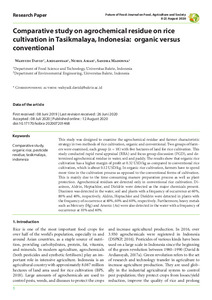Datum
2020-08-12Schlagwort
630 Landwirtschaft, Veterinärmedizin IndonesienTasikmalayaAgrikulturchemieRückständeReisanbauVergleichKonventioneller LandbauBiologischer PflanzenbauMetadata
Zur Langanzeige
Aufsatz

Comparative study on agrochemical residue on rice cultivation in Tasikmalaya, Indonesia: organic versus conventional
Zusammenfassung
This study was designed to examine the agrochemical residue and farmer characteristic strategy in two methods of rice cultivation, organic and conventional. Two groups of farmers were examined, each group (n = 18) with five hectares of land for rice cultivation. This study conducted rapid rural appraisal (RRA) and focus group discussion (FGD), and determined agrochemical residue in water, soil and paddy. The results show that organic rice cultivation has a higher margin of profit at 0.32 USD/kg as compared to conventional rice cultivation, which is about 0.12 USD/kg. In organic rice cultivation, farmers have to spend more time in the cultivation process as opposed to the conventional forms of cultivation. This is mainly due to the time-consuming manure preparation process as well as plant protection. Agrochemical residues are detected only in conventional rice cultivation. Diazinon, Aldrin, Heptachlor, and Dieldrin were detected as the major chemicals present. Diazinon was detected in the water, soil and plants with a frequency of occurrence at 60%, 80% and 40%, respectively. Aldrin, Heptachlor and Dieldrin were detected in plants with the frequency of occurrence at 40%, 60% and 60%, respectively. Furthermore, heavy metals such as Mercury (Hg) and Arsenic (As) were also detected in the water with a frequency of occurrence at 10% and 40%.
Zitierform
In: Future of Food: Journal on Food, Agriculture & Society Volume 8 / No 2 (2020-08-12) EISSN 2197-411XSammlung(en)
Vol 08, No 2 (2020) (Future of Food: Journal on Food, Agriculture & Society // The Future of Food Journal: Journal on Food, Agriculture & Society)Zitieren
@article{doi:10.17170/kobra-202007201468,
author={Wahyudi, David and Ardiansyah, Ardiansyah and Asiah, Nurul and Madonna, Sandra},
title={Comparative study on agrochemical residue on rice cultivation in Tasikmalaya, Indonesia: organic versus conventional},
journal={Future of Food: Journal on Food, Agriculture & Society},
year={2020}
}
0500 Oax
0501 Text $btxt$2rdacontent
0502 Computermedien $bc$2rdacarrier
1100 2020$n2020
1500 1/eng
2050 ##0##http://hdl.handle.net/123456789/11716
3000 Wahyudi, David
3010 Ardiansyah, Ardiansyah
3010 Asiah, Nurul
3010 Madonna, Sandra
4000 Comparative study on agrochemical residue on rice cultivation in Tasikmalaya, Indonesia: organic versus conventional / Wahyudi, David
4030
4060 Online-Ressource
4085 ##0##=u http://nbn-resolving.de/http://hdl.handle.net/123456789/11716=x R
4204 \$dAufsatz
4170
5550 {{Indonesien}}
5550 {{Tasikmalaya}}
5550 {{Agrikulturchemie}}
5550 {{Rückstände}}
5550 {{Reisanbau}}
5550 {{Vergleich}}
5550 {{Konventioneller Landbau}}
5550 {{Biologischer Pflanzenbau}}
7136 ##0##http://hdl.handle.net/123456789/11716
<resource xsi:schemaLocation="http://datacite.org/schema/kernel-2.2 http://schema.datacite.org/meta/kernel-2.2/metadata.xsd"> 2020-08-24T12:39:44Z 2020-08-24T12:39:44Z 2020-08-12 doi:10.17170/kobra-202007201468 http://hdl.handle.net/123456789/11716 eng Urheberrechtlich geschützt https://rightsstatements.org/page/InC/1.0/ Comparative study pesticide residue organic rice soil water organic Tasikmalaya Indonesia 630 Comparative study on agrochemical residue on rice cultivation in Tasikmalaya, Indonesia: organic versus conventional Aufsatz This study was designed to examine the agrochemical residue and farmer characteristic strategy in two methods of rice cultivation, organic and conventional. Two groups of farmers were examined, each group (n = 18) with five hectares of land for rice cultivation. This study conducted rapid rural appraisal (RRA) and focus group discussion (FGD), and determined agrochemical residue in water, soil and paddy. The results show that organic rice cultivation has a higher margin of profit at 0.32 USD/kg as compared to conventional rice cultivation, which is about 0.12 USD/kg. In organic rice cultivation, farmers have to spend more time in the cultivation process as opposed to the conventional forms of cultivation. This is mainly due to the time-consuming manure preparation process as well as plant protection. Agrochemical residues are detected only in conventional rice cultivation. Diazinon, Aldrin, Heptachlor, and Dieldrin were detected as the major chemicals present. Diazinon was detected in the water, soil and plants with a frequency of occurrence at 60%, 80% and 40%, respectively. Aldrin, Heptachlor and Dieldrin were detected in plants with the frequency of occurrence at 40%, 60% and 60%, respectively. Furthermore, heavy metals such as Mercury (Hg) and Arsenic (As) were also detected in the water with a frequency of occurrence at 10% and 40%. open access Wahyudi, David Ardiansyah, Ardiansyah Asiah, Nurul Madonna, Sandra Indonesien Tasikmalaya Agrikulturchemie Rückstände Reisanbau Vergleich Konventioneller Landbau Biologischer Pflanzenbau publishedVersion EISSN 2197-411X No 2 Future of Food: Journal on Food, Agriculture & Society Volume 8 false </resource>
Die folgenden Lizenzbestimmungen sind mit dieser Ressource verbunden:
Urheberrechtlich geschützt

